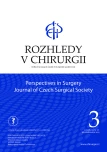Histologic tumor necrosis rate as a predictor of recurrence after surgical treatment for localized clear cell renal cell carcinoma
Authors:
M. Čechová 1; M. Chocholatý 1; J. Háček 2; M. Schmidt 1; M. Koldová 1; M. Babjuk 1
Authors‘ workplace:
Urologická klinika 2. lékařská fakulta Univerzity Karlovy a Fakultní nemocnice v Motole, Praha
1; Ústav patologie a molekulární medicíny 2. lékařská fakulta Univerzity Karlovy a Fakultní nemocnice v Motole, Praha
2
Published in:
Rozhl. Chir., 2022, roč. 101, č. 3, s. 114-118.
Category:
Original articles
doi:
https://doi.org/10.33699/PIS.2022.101.3.114–118
Overview
Introduction: Coagulative tumor necrosis (TN) is a potential negative prognostic marker in clear cell renal cell carcinoma (ccRCC). Our study assessed the significance of the TN rate in histological specimens in terms of the risk of recurrence in patients after surgical treatment for localized disease.
Methods: Our study included 149 subjects surgically treated for ccRCC from 2011 to 2014. Mean postoperative follow-up was 538 days. Presence of TN was assessed by a physician – pathologist in histological specimens. The following findings were described: without necrosis (79 samples), TN rate below 50% (46 samples) and TN rate higher or equal to 50% of the specimen (24 samples). The Kaplan-Meier method, log-rank test and Cox regression analysis were used to evaluate the disease-free survival (DFS).
Results: Seventeen patients experienced recurrence – with no TN detected in 3, TN rate below 50% in 6 and TN rate above 50% in 8 patients. There was a significant difference in DSF in patients with proven TN compared to patients without TN (HR 3.83; CI95% 1.48−9.94%; p=0.006; in multivariate analysis: p=0.031). Evaluation according to the proportion of TN showed a significant difference in DFS in patients with the TN rate below or equal to 50% compared to patients without TN (HR 16.27; CI95% 4.00−66.15; p=0.0001; in multivariate analysis: p=0.041). The difference of DSF between patients without TN and with the TN rate higher than 50%, and patients with the TN rate below 50% and higher than 50% was not statistically significant.
Conclusion: Our study confirmed TN as a risk factor of disease recurrence. Additionally, a higher TN rate is associated with a significantly higher risk of recurrence.
Keywords:
clear cell renal cell carcinoma – survival – coagulative necrosis – necrosis rate – prognostic factor
Sources
1. Capitanio U, Bensalah K, Bex A, et al. Epidemiology of renal cell carcinoma. Eur Urol. 2019;75(1):74−84. doi:10.1016/j.eururo. 2018.08.036.
2. www.svod.cz
3. Ljungberg B, Albiges L, Bedke J, et al. EAU Guidelines on renal cell carcinoma. Edn. presented at the EAU Annual Congress Milan 2021. ISBN 978-94-92671-13-4. EAU Guidelines Office, Arnhem, The Netherlands. Available at: https://uroweb.org/ guideline/renal-cell-carcinoma/.
4. Speed JM, Trinh QD, Choueiri TK, et al. Recurrence in localized renal cell carcinoma: a systematic review of contemporary data. Curr Urol Rep. 2017;18(2):15. doi:10.1007/s11934-017-0661-3.
5. Delahunt B, Cheville JC, Martignoni G, et al. The International Society of Urological Pathology (ISUP) grading system for renal cell carcinoma and other prognostic parameters. Am J Surg Pathol. 2013;37(10):1490−504. doi:10.1097/ PAS.0b013e318299f0fb.
6. Leibovich BC, Blute ML, Cheville JC, et al. Prediction of progression after radical nephrectomy for patients with clear cell renal cell carcinoma: a stratification tool for prospective clinical trials. Cancer 2003;97(7):1663−1671. doi:10.1002/ cncr.11234.
7. Warren AY, Harrison D. WHO/ISUP classification, grading and pathological staging of renal cell carcinoma: standards and controversies. World J Urol. 2018;36(12):1913−1926. doi:10.1007/ s00345-018-2447-8.
8. Sengupta S, Lohse CM, Leibovich BC, et al. Histologic coagulative tumor necrosis as a prognostic indicator of renal cell carcinoma aggressiveness. Cancer 2005;104(3):511−520. doi:10.1002/ cncr.21206.
9. Frank I, Blute ML, Cheville JC, et al. An outcome prediction model for patients with clear cell renal cell carcinoma treated with radical nephrectomy based on tumor stage, size, grade and necrosis: the SSIGN score. J Urol. 2002;168(6):2395−2400. doi:10.1097/01.ju.0000035885.91935.d5.
10. Klatte T, Said JW, de Martino M, et al. Presence of tumor necrosis is not a significant predictor of survival in clear cell renal cell carcinoma: higher prognostic accuracy of extent based rather than presence/absence classification. J Urol. 2009;181(4):1558−1564. doi:10.1016/j. juro.2008.11.098.
11. Katz MD, Serrano MF, Grubb RL 3rd, et al. Percent microscopic tumor necrosis and survival after curative surgery for renal cell carcinoma. J Urol. 2010;183(3):909−914. doi:10.1016/j.juro.2009.11.010.
12. Ljungberg B, Bensalah K, Canfield S, et al. EAU guidelines on renal cell carcinoma: 2014 update. Eur Urol. 2015;67(5):913−924. doi:10.1016/j. eururo.2015.01.005.
13. Amtrup F, Hansen JB, Thybo E. Prognosis in renal carcinoma evaluated from histological criteria. Scand J Urol Nephrol. 1974;8(3):198−202. doi:10.3109/00365597409132129. PMID: 4428182.
14. Ficarra V, Martignoni G, Lohse C, et al. External validation of the Mayo Clinic stage, size, grade and necrosis (SSIGN) score to predict cancer specific survival using a European series of conventional renal cell carcinoma. J Urol. 2006;175(4):1235−1239. doi:10.1016/ S0022-5347(05)00684-1.
15. Ito K, Seguchi K, Shimazaki H, et al. Tumor necrosis is a strong predictor for recurrence in patients with pathological T1a renal cell carcinoma. Oncol Lett. 2015;9(1):125−130. doi:10.3892/ ol.2014.2670.
16. Zhang L, Zha Z, Qu W, et al. Tumor necrosis as a prognostic variable for the clinical outcome in patients with renal cell carcinoma: a systematic review and meta- analysis. BMC Cancer 2018;18(1):870. doi:10.1186/s12885-018-4773-z.
17. Lam JS, Shvarts O, Said JW, et al. Clinicopathologic and molecular correlations of necrosis in the primary tumor of patients with renal cell carcinoma. Cancer 2005;103(12):2517−2525. doi: 10.1002/ cncr.21127.
18. Kuroe T, Watanabe R, Kojima M, et al. Evaluation of the morphological features and unfavorable prognostic impact of dirty necrosis in renal cell carcinoma. J Cancer Res Clin Oncol. 2021;147(4):1089−1100. doi:10.1007/s00432-020-03505-2.
19. Leibovich BC, Lohse CM, Cheville JC, et al. Predicting oncologic outcomes in renal cell carcinoma after surgery. Eur Urol. 2018;73(5):772−780. doi:10.1016/j.eururo. 2018.01.005.
Labels
Surgery Orthopaedics Trauma surgeryArticle was published in
Perspectives in Surgery

2022 Issue 3
Most read in this issue
- New trends in prostate cancer diagnostics
- Occult breast cancer: a case report and current management of treatment
- Penile amputation for sarcoma
- Risk of biochemical recurrence in patients with a positive surgical margin after radical prostatectomy
